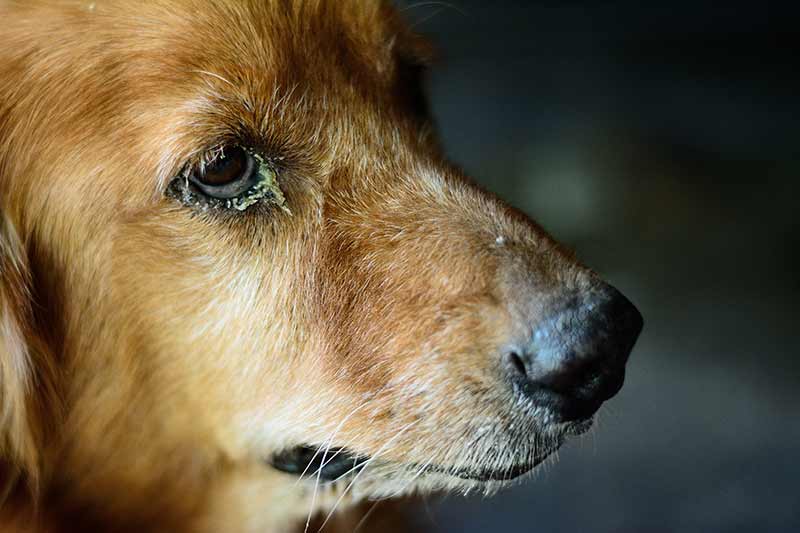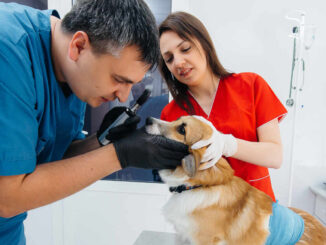
This article was updated on March 5th, 2023
A Vet Explains How to Tell the Difference
Your pup comes to you with runny eyes, squinting, and a pitiful look on their face-we’ve all seen it. And you’ve no doubt wondered if you’re dealing with dog eye allergies or a dreaded eye infection. While these two issues can look very similar to each other, we’re here to give you the tell-tale signs of each so that you can better differentiate what is going on with your dog’s eyes. Then we’ll look into some things that you can do to help relieve your dog’s discomfort.
What is the Difference Between an Eye Allergy and Eye Infection in Dogs?
Dog eye allergies and eye infections share many of the same signs, but they are very different issues with different treatments. The main difference between dog eye allergies and eye infections is the cause. Allergies are the result of irritation from allergens-most commonly dander, dust, pollen, mold, or chemical products. Eye infections happen when the tissues around the eyes or the eyeball itself become infected with a bacteria, virus, or fungus.
Here are some signs that you may see with either eye issue:
| Symptoms | Eye allergy | Eye infection |
| Clear, watery discharge | X | |
| Thick, colored discharge | X | |
| Redness | X | X |
| Swelling | X | |
| Squinting | X | X |
| Pawing or rubbing eye | X | X |
| Light sensitivity | X |
What Does a Dog Eye Allergy Look Like?
Any allergen that causes discomfort in the eyes is going to make dogs squint, rub or paw at the eye. There may also be redness of the eyeball or tissues around it, and of course, lots of watery discharge. Dogs with eye allergies may also have coughing, sneezing, and a runny nose to go along with it.


How Do I Know if my Dog Has an Eye Allergy?
Even though dog eye allergies and eye infections share many common signs, there are a few that are special to each issue. Dog eye allergies more often have a clear, watery discharge. There usually isn’t swelling around the eye unless your pup has been hard at work rubbing or scratching the eye, and they may have other signs like coughing, sneezing, and a runny nose.
Of course, the best real way to tell if your dog has an eye allergy is to see your veterinarian.
Causes of Dog Eye Allergies
Dogs can be allergic to any number of things. Some eye allergies develop as a puppy and others don’t show up until later in life. So, just because your dog is enjoying their senior years doesn’t mean they can’t be suffering from an eye allergy. Causes of dog eye allergies include:
- Tree, grass and plant pollen
- Cigarette or outdoor smoke
- Mold, mildew
- Dust and dust mites
- Dander, hair
- Chemicals such as cleaners, perfumes, air fresheners, flea treatments, garden chemicals
Some of these causes will be seasonal and others can wreak havoc all year around. If you suspect any of these environmental causes, try to reduce or eliminate them from around your dog and see if things clear up.
Treatment for Dog Eye Allergies
Dog eye allergies can be hard to get a good handle on, especially if you’re not exactly sure which allergen is to blame. The best treatment for dog eye allergies is to remove the allergen from their environment. Since that isn’t always possible, you and your vet may try some of the following treatments:
At-Home Eye Allergy Treatments
Flush the eye with sterile saline solution to help remove irritants. You may also want to wipe around the eye with a warm, wet washcloth. This can be done 3-4 times a day, especially after going outside.
You may also try an over-the-counter antihistamine to help relieve allergy symptoms. Products like Benedryl work on the whole body to reduce the immune system’s response to histamine. It may take a couple of weeks to see a difference. Be sure to consult your veterinarian for a proper dosage and possible side effects.
Veterinary Eye Allergy Treatments
When your vet diagnoses eye allergies in your dogs, they may prescribe an anti-inflammatory eye drop that will help reduce the redness and itchiness. These eyedrops may contain steroids, so it’s important to get a proper diagnosis first.
If your dog is having other allergy symptoms besides just their eyes, your vet may prescribe an oral antihistamine/anti-inflammatory to help control all of their itchiness and irritation. They may also recommend giving omega-3 supplements to boost the immune system.
Diagnostics and medications aren’t too expensive and usually run between $10-$30.
What Does a Dog Eye Infection Look Like?
On the other side of it, a dog eye infection may also show up with rubbing, squinting, and redness, but they may also have a thick, colored discharge and swelling around the eye. If the eye infection is caused by trauma to the eye, the eyeball may appear blue or red as well.



For more on dog eye infections, read 14 Pictures of Dog Eye Infections.
Causes of Dog Eye Infections
An eye infection occurs when the eyeball or the tissues surrounding the eye become infected with a bacteria, virus, or fungus. This can happen after an injury or trauma to the eye or following an illness.
Eye trauma can happen if your dog scratches or pokes the eyeball with toenails, teeth, grass, or sticks. Sometimes, a dog’s own eyelashes may be to blame. Smaller injuries may be hard to see, so don’t rule them out without a veterinary exam.
Infections can affect the eyes only or in some cases, may cause a dog illness in other areas as well. Along with an eye infection, your dog may also be having coughing and sneezing, a fever, or vomiting and diarrhea.
Treatment for Dog Eye Infections
As with dog eye allergies, there are a few at-home treatments that you can try first. However, most eye infections are going to require veterinary treatment.
At-Home Eye Infection Treatments
Flushing with sterile saline 2-3 times a day can help reduce your dog’s eye infection discomfort as well. They will definitely appreciate a thoroughly wiping with a warm, wet washcloth. If the eye doesn’t look better in 48 hours, or if it gets worse, see your veterinarian. Read our article:
Veterinary Eye Infection Treatments
Your vet will more than likely start off with some diagnostics to determine if there is an injury to the eyeball to ensure a proper treatment. From there, they will prescribe an antibiotic or antifungal eyedrop that will need to be given until the infection is cleared.
They may also need to remove foreign objects, if that’s the inciting cause, or they may need to do a corrective surgery to fix any abnormalities.
Most treatments and diagnostics will cost $100-$150.
When to See a Vet for Dog’s Eye Issue or Discharge
If this is your dog’s first bout of watery, red eyes, your best bet is to see your veterinarian. Even simple eye allergies should be properly diagnosed to make sure something more serious isn’t going on.
However, if your dog is no stranger to seasonal allergies, you may try the at-home treatments first, or any other tried and true options that you’ve come across. If the eyes don’t start to look better after trying these options for 2-3 days, see your vet.
If you suspect your pup has an eye infection or eye injury, don’t hesitate to see your vet. Most eye infections aren’t going to clear on their own, so you’ll want to get started on some prescription medications as soon as possible.
FAQs with the Vet
Can I use human eye drops for my dog?
Human eyedrops are meant for humans and dog eyedrops are meant for dogs. The medications and dosages are formulated differently in order to best treat humans and could even be dangerous to use on dogs. However, sterile saline designed for humans can be used to flush dog eyes.
Which dog breeds get eye allergies?
No dog breed is completely immune to getting eye allergies, however some breeds are more prone. These are usually the breeds that are more prone to allergies in general and include: Cocker Spaniels, Labs, Golden Retrievers, Boxers and Shih Tzus.
Can dog eye infections or allergy issues go away on their own?
Most dog eye infections won’t go away on their own. They will require antibiotic treatment. Dog eye allergy signs may come and go depending on what allergen is causing them. Some may be seasonal and others may be year-round.
Is my dog’s eye infection contagious to humans and other pets?
A dog’s eye infection may be contagious to humans and other pets depending on what microbe is causing it. Some are species specific and others are capable of infecting other species.
Will Benedryl or other home medications help my dog’s eye infection?
Benedryl is an antihistamine that may help with a dog’s eye allergies but will most likely not do anything for their eye infection. Most dog eye infections will require veterinary treatment.
Related posts about dog eye issues:

Disclaimer: This website's content is not a substitute for veterinary care. Always consult with your veterinarian for healthcare decisions. Read More.





Be the first to comment